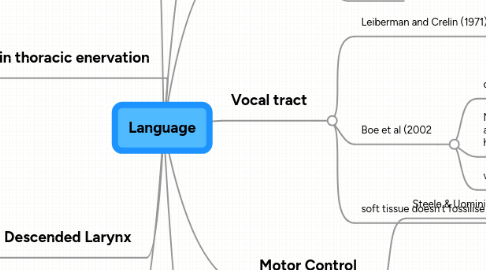
1. Descended Larynx
1.1. Nishimura et al, 2006
1.1.1. Humans not unique in having descended larynx
1.1.1.1. descends in infancy
1.1.2. Chimps also experience descent
1.2. Facial flattening in humans associated with Vocal Tract form
1.2.1. Two processes – descent (primitive) and flattening (derived)
1.3. Fitch 2000
1.3.1. Temporary descending in many mammals
1.3.2. Permanent descending in Red Deer
1.3.2.1. sound propagation; or to exaggerate body size (communication as power; bluffing over honesty?
2. Hyoid
2.1. Neanderthal hyoid bone was found in Kebara Cave
2.1.1. suggest could speak
2.2. Primates show species differences in hyoid morphology
2.2.1. neanderthals and humans show similarities
3. Increase in thoracic enervation
3.1. during human evolution
3.2. help posture with bipedalism?
3.3. increased control for breathing for speech
3.3.1. need to produce long exhalations of air
3.4. Respiratory control evolved between 1.6mya and 100kya,
3.5. MacLarnon and Hewitt (1999)
4. Hyporglossal canal
4.1. Kay et al (1998)
4.1.1. larger in Homo sapiens than African apes
4.1.1.1. Hypothesis that the human tongue needs more motor nerves
4.1.1.2. Look at canal size in fossil hominins
4.1.1.2.1. Australopithecus and Homo habilis fall within size range of Pan
4.1.1.2.2. Neanderthals and early modern humans fall within extant Homo
4.1.1.2.3. Suggests that vocal capabilities of Neanderthals same as humans
4.2. Transmits nerve that supplies muscles of the tongue
4.3. DeGusta et al (1999) suggest canal not correlated well to speech
5. Language: speech/noises?
5.1. Bernal & Ardila 2009
5.1.1. Conduction aphasia is a speech, not language problem
5.1.2. Non-human animals can repeat human speech but do not understand it
5.1.2.1. Repetition may help us learn language
5.2. Ouattara, et al 2009
5.2.1. Cambell's Monkeys
5.2.1.1. Adult males have 6 call types
5.2.1.1.1. proto-syntax
5.2.1.2. predator types, falling trees, neighbouring groups,
5.2.1.2.1. Calls and combinations not spontaneous
5.2.1.3. But are vocalisations like these in primates a precursor to language?
6. Speech
6.1. Complex, needs more muscles than any other activity
6.2. Need to control breathing
6.3. Need processing skills, transmit quickly
6.4. Brain size
7. Vocal tract
7.1. Leiberman and Crelin (1971)
7.1.1. In humans the low larynx which allows speech is associated with a highly flexed cranial base.
7.1.2. Neanderthals have a flatter cranial base, so limited?
7.1.2.1. had emphasised the short ape-like neck and forward position
7.2. Boe et al (2002
7.2.1. criticises Leiberman et al (1971)
7.2.2. Neanderthal vowel space was as large as that of modern humans
7.2.3. vocal tract proportions are similar to a ten year old human
7.3. soft tissue doesn't fossilise
8. Larger Brain size
8.1. dunbar- keep track of social connections which can often help with survival if the subsistence is hunter/gathering or hominins lived in groups.
8.1.1. Aiello and Dunbar (1993)
8.1.1.1. In primates strong link between brain size and group size
8.1.1.1.1. Language evolves as ‘verbal grooming’
8.1.1.2. Group size limited by number of relationships can monitor
8.1.1.2.1. relative size of neocortex
8.2. Several brain regions, including Wernicke’s and Broca’s area associated with speech in humans
8.2.1. link to motor control
8.2.1.1. Assumption that existing areas co-opted for language use and expanded to enable new tasks
8.2.2. connected? strong in humans, superficial in chimps
8.3. Gradual evolution in primate lineage
8.3.1. Human emphasis on projection towards temporal lobe: lexicalsemantic processing
8.3.1.1. Chimps have a less developed, superficial linkage suggests that the brain development that could allow for speech developed in the late homo lineage where there was a significant rise in cranial capacity compared to apes.
8.3.1.1.1. Rilling et al 2008; Ghazanfar 2008
9. Motor Control
9.1. Steele & Uomini 2009
9.2. Handedness- language and motor lateralised
9.2.1. Humans 8:1; some evidence captive chimps 2:1
9.2.2. As right-handedness increases in population, so do language abilities
9.2.3. Investigate handedness in lithics
9.2.3.1. Handed tools, striations on teeth show holding
9.2.3.1.1. 15/15 H. heidelbergensis individuals, Atapuerca
